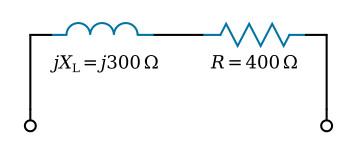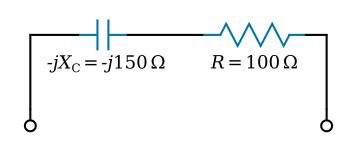Home > Textbooks > Basic Electronics > AC Circuits > Impedance and Admittance >
AC Circuits
Impedance and Admittance
Impedance is the general expression for opposition to current in alternating current circuits. Impedance may be pure resistance or pure reactance, but usually it is a combination of resistance and reactance. The symbol Z is used for impedance, which is expressed in ohms. Impedance takes the general phasor form
![]()
Impedance is shown on the complex plane in the figure below.

Impedance is the ratio of phasor voltage to phasor current in an AC circuit, as shown by the equation below:

Equation above is the general Ohm's-law relationship for AC circuits, and the equation can be handled algebraically in the usual way. It must be remembered that computations involving phasors must be done as outlined in the section about complex numbers.
Example 1: The impedance of the circuit of figure below is
![]()

Example 2: The impedance of the circuit of figure below is
![]()

Admittance has the symbol Y and is defined as the reciprocal of impedance. Admittance is expressed in mhos or siemens (symbol S).
Example 3: Calculate the impedance and admittance of the circuit of figure below at a frequency of 150 Hz.

Solution:







